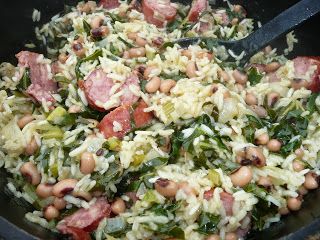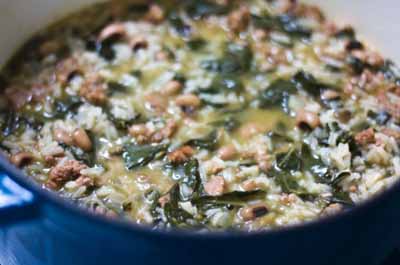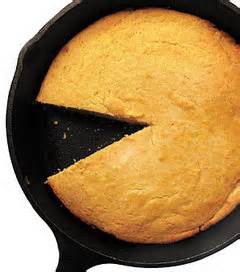Good Luck Beans

“Eat poor that day, eat rich the rest of the year. Rice for riches and black-eyed peas for peace.”
– Southern motto on eating a dish of Hoppin’ John on New Year’s Day.
It is the day after New Years Eve. I had a strategy to deal with it. I went out to Fairfax to visit my favorite restaurant that isn’t Willow for a couple belts, and then motored back into the Imperial City on I-66 to wish the staff a prosperous new year.
Tracey O’Grady was briefing her crew on how the food was supposed to be presented to the 300 diners who were going to appear shortly, and the cuts of meat and seafood dishes sounded fantastic. I wasn’t there to eat, I just wanted to see everyone, and as the amateurs began to arrive, I packed it in and went home.
I was in bed before nine, and never did get around to cooking the Hoppin’ John for New Year’s Day Southern Good luck. It is OK- I have a strategy for that, too. I will get to that in a minute.
If I had cooked up a batch, my little cast iron Lodge skillet and the new/old Griswold #7 at the farm would double team to do the cornbread to go along with it- the keys to success in the new year.
The cornbread pan with the ears-of-corn design, the Dutch oven and the big 14 inches (a vintage Erie) enable me to cook for an army.
There have been some grim New Year’s Days down at the farm, in which no amount of black-eyed peas would help out. The January 1st of 1864 would have been one. There were only about 80 civilians left in the whole of Culpeper, that January, but there were 100,000 Union soldiers camped out all over Culpeper County.
“The whole country, besides the mud, is now ornamented with stumps, dead horses and mules, deserted camps, and thousands upon thousands of crows,” complained one Union officer of the hordes of black birds feasting on the entrails of slaughtered animals.

(A March, 1864 photo from the Library of Congress depicts the 3rd Army HQ on Fleetwood Hill at Brandy Station, the logistics hub of the Army of the Potomac in northern Culpeper. The famous Spite House, built to irritate the preservationists stood to the left of center. Image Library of Congress).
“Culpeper’s dwindling civilian population witnesses … the establishment of the Union camps in stunned belief. It is bad enough that much of their surviving property is taken and their timber cut down for Yankee shelter, but they are cast into despair when forced to watch neighborhood churches, fences, outbuildings, slave quarters and the unoccupied houses of absent neighbors torn down for their lumber.”
“The Court House, in particular, is a dismal place. The courthouse building and slave pen have been transformed into prisons for Confederates.” I have been in one that survived in the basement of the Hazel River Inn on E. Davis Street. It is still spooky.
Hoppin’ John, which some people say was named after a kitchen slave called John, is a must; to not eat this wonderful, comforting dish of rice topped with black-eyed peas, ham and a variety of condiments is to risk woe, misfortune, or worse.
Hoppin’ John is a rich bean dish made of black-eyed peas simmered with spicy sausages, ham hocks, or fat pork, rice, and greens.
This African-American dish is traditionally a high point of New Year’s Day, when a shiny dime is often buried among the black-eyed peas before serving. Whoever gets the coin in his or her portion is assured good luck throughout the year. For maximum good luck in the new year, the first thing that should be eaten on New year’s Day is Hoppin’ John.
There are as many stories about the origin of the black-eyed pea dish as there are Southerners, but the one I like comes from the aftermath of the total war strategy used by the North after Grant’s Army left Culpeper for the Overland Campaign to seize Richmond.
The Shenandoah Valley was the breadbasket of Virginia, where much of the war was fought. Culpeper was devastated. Later, General Phil Sheridan burned everything of worth in the Valley a prelude to the deliberate destruction of everything in the path of General William T. Sherman’s devastating March to the Sea in 1864.
Sherman ordered his troops to strip the land of all food, crops, and livestock and to destroy anything they could not carry away. The troops followed their draconian orders and the surviving Southerners were left with nothing, and starvation loomed.
Except for one thing: Black-eyed Peas. The Black-eyed Pea supply was left completely intact, though not for some humanitarian purpose. They were left alone by ignorance of local custom by the Northerners. . The troops did not leave these Peas as some sort of good-will gesture. They just didn’t know people ate Black-eyed Peas.
In the North, Black-eyed Peas were known as “cowpeas” or “field peas”. Cattle ate cowpeas and humans ate only English Peas. Since the North believe only cattle ate Black-eyed Peas and they had already either taken or eaten all of the cattle, they saw no need to destroy this crop.
So, the salvation of the people of Virginia and Georgia was directly related to the good luck of the Yankee culinary illiteracy.
And in the dark days that preceded the end of the war, that was Good Luck indeed.
Here is my take on the southern dish- featured on the menu of the venerable Army-Navy Club on Farragut Square, where I intend to take my lunch later today. Some folks cook the peas and rice in one pot, while others insist on simmering them separately. I tend to go with the one pot approach, but I understand purists.
Traditional Hoppin’ John

Ingredients
1 pound dried black-eyed peas
2 small smoked ham hocks or meaty ham bone
2 medium onions, divided
3 large cloves garlic, halved
1 bay leaf
1 cup long-grain white rice
1 can (10 to 14.5 ounces) diced tomatoes with chile peppers, juices reserved
1 medium red bell pepper, chopped
1/2 green bell pepper, chopped
3 ribs celery, chopped
1 jalapeno or serrano pepper, minced
2 teaspoons Cajun or Creole seasoning- you can make your own or buy it prepared
1/2 teaspoon dried thyme leaves
3/4 teaspoon ground cumin
3/4 teaspoon salt
4 scallions, sliced
Yield: 6 Servings. You could feed the Army of the Potomac by simply increasing the amount of ingredients 16,666 times.
Directions
In a large vintage cast iron Erie skillet, combine the black-eyed peas, ham bone or ham hocks, and 6 cups water. Cut 1 of the onions in half and add it to the pot along with the garlic and bay leaf. Bring to a boil, reduce the heat to medium-low, and simmer gently until the beans are tender but not mushy. It could take a couple bottles of wine, if the company is good, maybe two and a half hours.
Pull the ham and cut off the meat; dice and set aside. Drain the peas and set aside. Remove and discard the bay leaf, onion pieces, and garlic.
Add 2 1/2 cups of water to the pot and bring back to a boil. Add the rice, cover, and simmer until the rice is almost tender for about a glass of wine- 10 to 12 minutes, remember to pace yourself.
Mince the remaining onion then add to the rice along with the peas, tomatoes, and their juices, red and green bell pepper, celery, jalapeno pepper, Creole seasoning, thyme, cumin, and salt. Cook until the rice is tender, 5 to 8 minutes. Stir in the sliced green onions and the reserved diced ham.

Serve with Louisiana hot sauce and freshly baked cornbread (recipe at http://vicsocotra.com/stories/11-25-09-cornbread.htm). It being New Year’s Day, add some Mustard or Turnip Greens for luck. You can cook them separately or throw them right in. Wash your greens 3 or 4 times in fresh water, draining well, since gritty greens suck. Strip the leafy part from the stems and throw the stems to the chickens, if you got any.
In a large pot fry down 1 lb. of fat back, thick bacon, or ham chunks til brown. Add the greens and simmer until the they start to wilt. Add two cups of water and cook till tender, and refresh the water if it gets low. Stir and fry all this until greens start to wilt. Add 2 cups of water and cook until tender.
Add more water if necessary.
You can add a spoon of sugar in the water to sweeten the greens. Stir frequently on medium heat so they don’t burn.
I cannot guarantee that this Hoppin’ John will bring you good luck, but I know that black-eyed peas were sure good for the people of Culpeper in the Winter of 1864.
Happy New Year!
Copyright 2014 Vic Socotra
www.vicsocotra.com
Twitter: @jayare303
